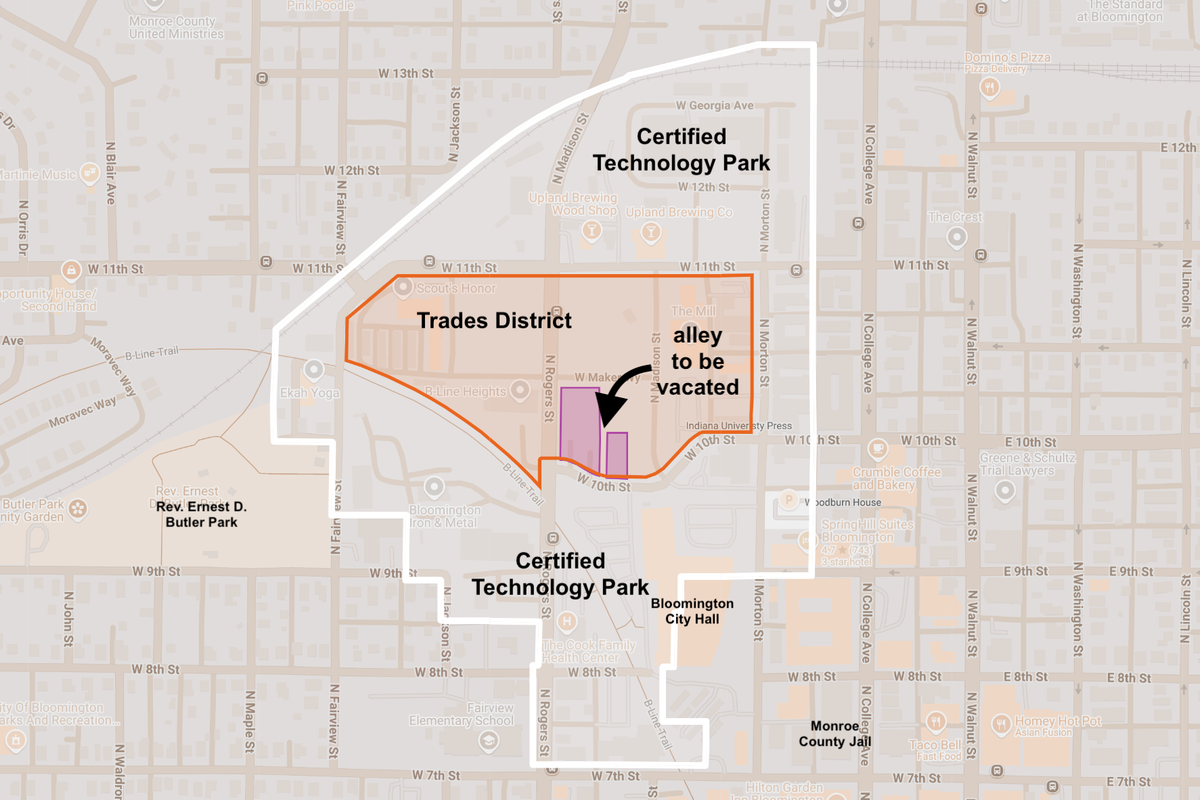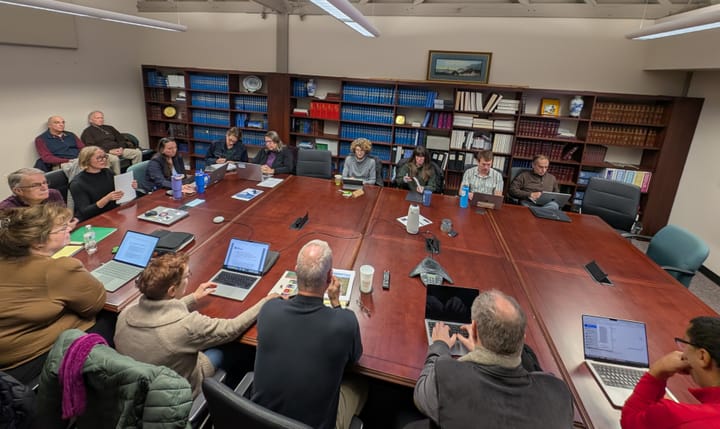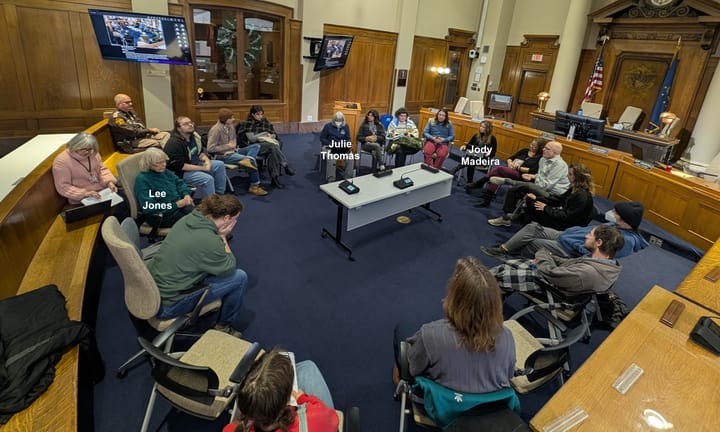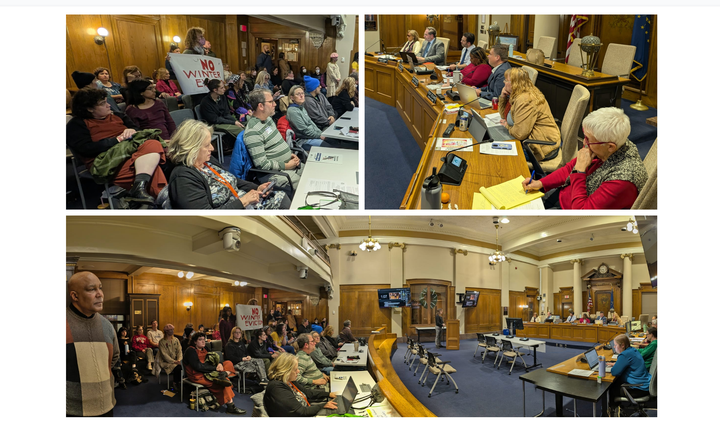Bloomington city council gives up right-of-way for easier development of Trades District hotel

The vacation of an alley in Bloomington's Trades District was approved by the city council at its regular Wednesday meeting.
Giving up the government's right to the public right-of-way in the form of an alley will make it easier for Alluinn IU Trades District Hotel to develop a 150-bed upscale hotel there—on two vacant parcels that are currently split by the north-south platted alley.
In mid-March, Bloomington's redevelopment commission (RDC), as the owner of the land, had approved the petition to the city council for the alley vacation.
The tally for the council's vote was 7–1. Sydney Zulich was absent. Dissenting was Matt Flaherty.
If all goes to plan, the hotel could be open sometime in the second half of 2026.
Bloomington's RDC has a pending agreement with Alluinn IU to purchase the property for $1.2 million. The alley vacation is needed in order for the purchase, and subsequent development to go through.
The RDC's resolution resolution to petition the city council to vacate the platted alley says "the presence of said alley would significantly hinder Alluinn IU's development of a hotel on the real estate to be conveyed."
Presenting the item to the city council on Wednesday was John Fernandez, who is now president of The Mill, which is now handling the redevelopment of the Trades District.
Fernandez told RDC members at their mid-March meeting that the current platted alley poses design challenges for the planned hotel. Fernandez said that when architects for Alluinn IU started laying out the hotel on the site, it became clear that building over the alley is "suboptimal." Fernandez described the result of the attempt to create a structure above the alley as a "funky" design.
Instead of building over the alley, the developers have proposed vacating the southern half of the existing platted alley, which runs north-south, and replacing it with a new east-west alley that would run from Madison Street to the southern end of the north-south alley that would remain.
The proposed alley swap is part of a larger site plan that aims to optimize the hotel's design and functionality, Fernandez said.
In presenting the request to the council at Wednesday's meeting, Fernandez pointed to the fact that it's a platted alley, but has not ever functioned as an alley. "It's not really an alley vacation, because an alley has never existed. It's platted on the subdivision for this particular part of the Trades District, but it's never been an alley," Fernandez said. He added, "It's not like we're giving up something that the community has been using and has relied upon, whether for pedestrian or vehicular traffic."
In dissenting, Flaherty took up the idea that there has never been an actual alley at the location. He said, "I think, when it comes to the fact that it's not currently utilized as an alley—or this is like a blank slate—I think, to me, that is like a little bit of the wrong question. It's not about what this was, it's about what it could be, for the future." He added, "When we vacate right-of-way, we give it up forever."
Flaherty also appeared unconvinced by the idea that the swap of an old alley for a new one was adequate, because the Trades District should have been platted with a full grid in the first place. Flaherty put it like this: "I think we haven't done a great job on a lot of fronts historically as a city both, for instance, when when the Trades District was replatted, we probably should have platted a full grid of alleys."
Flaherty gave a reminder of the push the council had to make, to get the previous city administration under mayor John Hamilton, to include alleys as a part of the replatting for the Hopewell neighborhood.
In early June 2022, the city council did eventually approve the vacation of some alleys in connection with the redevelopment of the former site of the IU Health hospital, now called the Hopewell neighborhood.That request also came to the city council through the RDC. It was the same proposal that had failed at the city council on a 4–5 vote in the first week of April 2022.
Part of the understanding that was reached for the approval of the 2022 Hopewell alley vacations was for other alleys to be added, and for the planning department to develop a new zoning overlay that was applicable to the Hopewell neighborhood, called the Transform Redevelopment Overlay (TRO). The city council then adopted the TRO.
At the city council's Wednesday meeting, Bloomington's planning and transportation director David Hittle said that his department supports giving up the ROW, but that the support is conditioned on providing the east-west alley that would connect the southern end of the vacated alley eastward to Madison Street.
In Bloomington, the criteria for vacating public rights-of-way are ensconced in a resolution, approved by the city council in 1987. [Res 87-02] From that resolution, the criteria are:
1. Current Status – Access to Property: the current utilization of the right-of-way in question – as a means of providing vehicular or pedestrian access to private property, churches, schools, or other public places, for public utility or drainage purposes, or for other public purpose.
2. Necessity for Growth of the City:
a. Future Status – the future potential for public utilization, possible future need for the right-of-way due to future changes in land use;
b. Proposed Private Ownership Utilization – the proposed utilization of parcel in question if it reverts to private ownership, potential for increased benefit to the City under private ownership (does the proposed use contribute to the orderly growth of the City);
c. Compliance with regulations – the effect of vacation upon compliance with all applicable regulations: subdivision, zoning, access control, off-street parking (does the vacation present a non-compliance problem or hinder future compliance upon anticipated development or change of use?);
d. Relation to Plans – the relationship of vacation with the Master Plan, Thoroughfare Plan, Neighborhood Plans, or any special studies that might apply




Comments ()